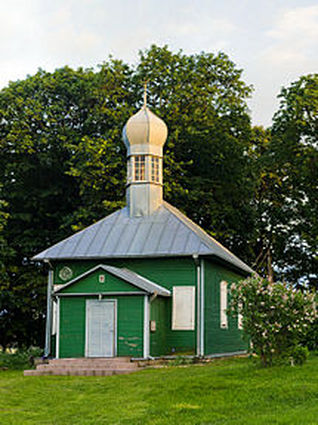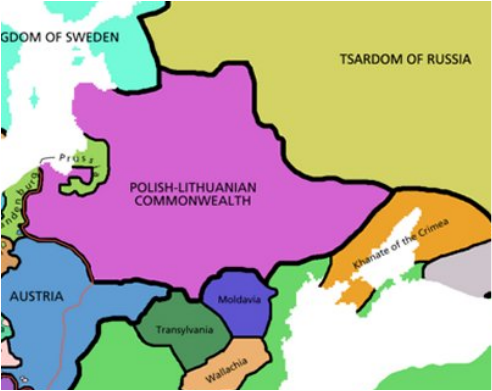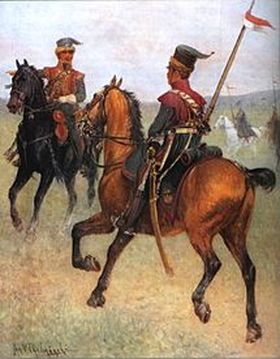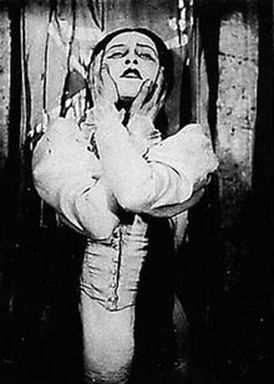If you didn't think there were Christians living in the shtetl, then you probably really didn't think there were Moslems.
But guess what? There were: members of a people known as the Lipka Tatars, whose lives intersected with those of their Jewish neighbors in some totally fascinating ways, involving magic spells, magic amulets ... and maybe even marriage.
| (Among the fortifications built to repel Crimeans and Cossacks were stone "fortress synagogues," according to Jeffrey Veidlinger's In the Shadow of the Shtetl: Small-Town Jewish Life in Soviet Ukraine.) The Lipka, though related to the Crimeans, had a very different history. Their arrival in what is now Poland, Lithuania and Belarus dates back to 1397, just after they lost a power struggle with the notorious Mongol leader Timur, or Tamerlane, of pyramid-of-skulls fame. |
| For most of the next several hundred years, Lipka fought as cavalrymen alongside the army of the Polish-Lithuanian Commonwealth (or as part of that army), enjoyed privileges as Polish noblemen, and built more than a hundred mosques in Commonwealth lands. (These mosques were usually wooden and painted green, like the one pictured above, and included women's galleries.) |
According to Marek Dziekan, in History and culture of Polish Tatars, "Polish people often considered Tatars to be sorcerers." More specifically, Tatars had a reputation as extraordinary healers--a reputation in which their Jewish neighbors firmly believed.
| We learn from various authors that, in a milieu rife with folk healers of various stripes, Jews particularly favored the Tatars*; and that the "acknowledged experts in the use of spells as well as herbs were the Tatars, and when an illness was so serious that it could not be cured by the exorcism of a dybbuk or the use of conventional medicine, the Tatars were called upon for help."** | * Deutsch, The Jewish Dark Continent ** Eliach, There Once Was A World |
| What kind of magic did these Tatar healers practice? This very question was asked by the great ethnographer S. Ansky, author of the play The Dybbuk, in the questionnaire that he and his associates took around to Jews of the Pale between 1912-1914: "Are there Tatars in your community, old male and female gentiles, who heal? What provisions and remedies do they offer?" Here are some answers: One technique involved "reading Muslim prayers and blowing on the patient. Such technique was supposed to cleanse the body by 'blowing away' the sickness that came from the air. The second most popular method was fumigation. A page from a prayer book or a specially written amulet was supposed to be burned on coals and the sick one was expected to inhale the smoke while listening to specially chosen prayers. This was a way of dispelling 'charms'. Another use for cards with writing was to wash away the text and drink the used water." This last was said to be "a good cure for epilepsy and giddiness."*** | *** According to Shirin Akiner, in Religious Language of a Belarusian Tatar Kitab |
| How else did Jews and Tatars interact? Yaffa Eliach tells us that, in the shtetl of Eishyshok, Jews and Tatars were friends, and that during World War II, Tatars (and Christians) aided their Jewish friends there. In some shtetlekh, for example Lyakhovichi, Jews and Tatars were close neighbors: "The street Tatarskaya was named for the primary street of their residence and that of their mosque, but it was not exclusive to them, Jews lived on Tatarskaya also." |
I haven't been able to find documentation of these documented cases (though it's true that Tatars were a very small minority in some towns.) But I did learn of one way in which Jews were definitely able to help their Tatar neighbors out:
"Circumcision is called siunniet (from Arab. sunna, Tur. sünnet – ‘tradition’), by Tatars ... It was formerly done by specialised ritualists called siunnietdży, who were often Jews."





 RSS Feed
RSS Feed